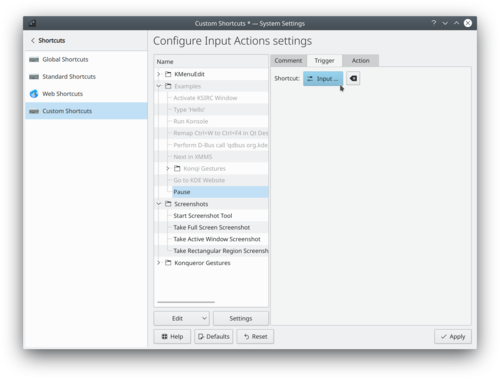Tutorials/hotkeys: Difference between revisions
m (formatting) |
m (don't open a new terminal emulator, just to open the system settings) |
||
| Line 4: | Line 4: | ||
<!--T:1--> | <!--T:1--> | ||
With KDE you can set any key or a combination of keys to trigger an action on your computer. As an example: when I ''pause'' my work I want to lock my screen with the <keycap>Pause</keycap> key so my colleagues cannot [http://zvon.org/comp/r/ref-Jargon_file.html#Terms~baggy_pantsing baggy-pants] me. Here is how to do that. | With KDE you can set any key or a combination of keys to trigger an action on your computer. As an example: when I ''pause'' my work I want to lock my screen with the <keycap>Pause</keycap> key so my colleagues cannot [http://zvon.org/comp/r/ref-Jargon_file.html#Terms~baggy_pantsing baggy-pants] me. Here is how to do that. | ||
<!--T:3--> | <!--T:3--> | ||
* | * Open the [[Special:myLanguage/System Settings|System Settings]] | ||
<!--T:4--> | <!--T:4--> | ||
Revision as of 13:22, 20 April 2019
With KDE you can set any key or a combination of keys to trigger an action on your computer. As an example: when I pause my work I want to lock my screen with the Pause key so my colleagues cannot baggy-pants me. Here is how to do that.
- Open the System Settings
- Select → → → → → and enter
Pause
- In the tab, click on
- Press the Pause key
- Go to the tab
- Enter
qdbus org.kde.screensaver /ScreenSaver org.freedesktop.ScreenSaver.Lock
or (whatever works)
/usr/lib64/kde4/libexec/kscreenlocker_greet
or (whatever works)
/usr/lib64/kde4/libexec/kscreenlocker --forcelock
- Click
- test it by pressing the Pause key

